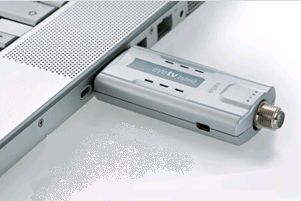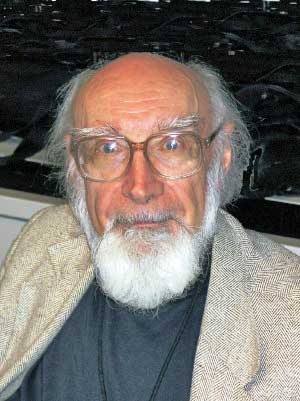|
This site has many more reviews, all written by MLMUG members.
View all our book reviews. Or, view our
Software, hardware, and game reviews.
A Hardware Review
by James F. Weiher
Review Date: January 2007
 |
Product: EyeTV Hybrid
Company:
Elgato Systems
List Price: $149.95
Minimum System Requirements: G4 with 256MB RAM and USB2
Test Systems: 1.25 GHz MDD G4 with 1.25GB RAM, 80 GB HD, OS-X 10.4.7, and
1.67 GHz G4 PB with 1.5GB RAM and 100 GB HD, OS-X 10.4.7
Reviewer's Rating: 4 out of 5 Apples |
Elgato's EyeTV Hybrid is an exciting new product. If you want to watch
digital or analog TV on your Mac and/or record programs for later viewing or
editing, you will certainly want to consider this product. It is TiVo for
your Mac and more. It comes bundled with Elgato's EyeTV 2 software which
has many advanced features.
If you have a Dual Processor G5 or an Intel Duo Core Mac you can take full
advantage of the EyeTV Hybrid to view and record both standard Analog and
Digital TV broadcasts at full 720x480 DVD resolution as well as full
resolution High Definition 1920x1080 broadcasts. With earlier, less
powerful, later model G4s you will be limited to recording at 352x240 Video
CD quality, although viewing at 720x480 is possible. Since the EyeTV Hybrid
has no hardware encoder, all digitizing and compression must be done in
software. Thus recording performance is limited by CPU power. To explore the
lower end limit I've checked the EyeTV Hybrid with my 1.67 GHz G4 PowerBook
and with my 1.25 GHz MDD G4.
With the 1.25 GHz G4 the display of live TV is excellent and recordings at
Video CD quality are without frame dropouts or other artifacts. If no other
programs are in core and the TV display window is closed, recording at 120
min DVD quality is just possible, with only a rare frame dropout or other
video artifact. The software gives you a warning that you need a dual G5 or
Intel Mac, but just close the window and start recording. With the 1.67 GHz
G4 recording at 120 min DVD quality is without problems as long as the TV
display window is closed and there is not undue competition from other
programs. With neither processor are recordings at 90 min DVD quality
possible; there are so many dropped frames that the video looks like a slide
show of stills although the audio is largely undistorted. It was difficult
to predict the occurrence of dropouts or artifacts by looking at CPU usage
with the activity monitor because both EyeTV demands on CPU and system
demands fluctuate rapidly and greatly. However if total usage never gets
above about 90% there should not be a problem; if it gets above that and
especially if it intermittently gets to 99 or 100%, there will be frame
dropouts and artifacts; if it is 100% most of the time, the video will look
like a slide show even if the audio is OK.
The best solution to recording at highest resolution with G4 Macs is to use
a different TV tuner that has hardware encoding, e.g. Elgato's Eye-TV 250,
Miglia's Alchemy TV DVR system (now discontinued) or TVMax also from Miglia.
Using the Alchemy and its software on the 1.25 GHz G4 I obtain perfect full
resolution 720x480 MJPEG (essentially DV) recordings from analog TV
broadcasts, which can then later be compressed to whatever format desired.
Without extremely powerful processors, digitizing and compressing in live
time is always the least desirable option.
The real advantage of this product is its portability. For traveling, just
drop the little bigger than a flash drive EyeTV Hybrid and a few cables in
the case with your PowerBook or MacBook and you can view and record over the
air analog or digital TV or analog cable TV wherever you are. For digital
cable you do need a digital cable box, because those signals are almost
always encrypted or otherwise access limited by the cable company. In
addition with the Hybrid you will be ready for the upcoming transition to
over-the-air digital High Definition.
The connection to your computer is with the USB2 connector at one end of the
Hybrid and the connection to the TV signal is with the F-type connector at
the other end. The
breakout cable included in the box enables you to take advantage of composite
or S-video signals from a VCR, cable box or game box. No external power is
needed because the unit is bus powered. This means that you can't connect
with an non-powered USB2 hub or a keyboard port. Elgato says that the
connection requires a computer with a "built-in" USB-2 port, but I found
that the USB-2 on my 4-port PCI card in the MDD G4 works fine. You control
the system from the display menus, the keyboard, or the EyeTV IR remote that
comes with the unit. Elgato claims that 256 MB physical RAM is the minimum,
512 recommended. I suggest that the more RAM you have the better and
recommend at least 1 GB.
The real beauty that comes with the EyeTV Hybrid is the EyeTV-2 software.
This is so good that for its new TV hardware Miglia has dropped their own
and is using EyeTV 2. It has many fine features but a few limitations. This
is a universal binary optimized for both PowerPC and Intel processors. You
can:
- browse the menus in Full Screen Mode
- view live or recorded video in normal, reduced, enlarged or full screen mode
- edit out commercials or select clips to export
- export to a file in another format
- export to iPod, Toast, iMovie, etc.
- find programs and schedule recordings with the built in Program Guide.
- pause, rewind, fast forward if you are recording analog TV or viewing
digital
- enable or disable Closed Captioning if the program supports it
- change the screen aspect ratio to accommodate ratios other than 4:3
Although the EyeTV software is excellent, it took me a bit of experimenting
and browsing through the PDF manual to become accustomed to it because it is
a bit different from QT, iMovie and the Alchemy DVR software I normally use.
Both MPEG-1 and MPEG-2 formats are supported but MJPEG is not. Recordings
can be exported to most formats, including MPEG-4, DV, H.264, all with the
option of customizing the settings as desired. For the convenience of the
user a number of convenient presets can be chosen, e.g. for Email, Web,
iMovie, iDVD, Toast, iPod.
All in all this is a nice unit that will fill your TV needs well if your
computer is relatively new or your requirements not too great. Beyond the
shortcomings already discussed I encountered only a few minor irritations.
- The install CD did not mount on the first insertion, but readily mounted on the second.
- The software version on the install CD was 2.3.1, so after installation I
had to download and install 2.3.2.
- The hardware documentation on the CD covered other models, but not the
EyeTV Hybrid. During installation this was partially covered.
- Once after recording and editing a clip the software lost the ability to
see the TV channels. Quitting and relaunching EyeTV restored the signal
For a short demo of the Eye-TV Hybrid check out Elgato's site:
http://elgato.com/downloads/elgato_hottech.mov
Pros:
- small, compact, easily portable
- combined digital and analog tuner
- multiple inputs — F-type connector, S-Video, Composite
- can edit recordings and export clips to other formats
- supports MPEG-1 and 2 levels of MPEG-2
Cons:- no hardware encoding
- requires newer high performance computer for optimum performance
- no recording to MJPEG
- no enclosed printed manual
- no antenna in US version
|
 |
About the reviewer: James F. Weiher
Dr. Weiher has been involved with computers, one way or another, for over 50
years — mainframes, minicomputers, and microcomputers — in university and
government laboratories as well as research centers in private industry. For
the last 20 years he has recommended the Macintosh as the personal computer
of choice — be it on the desktop or on the road. He says: "The Mac is the
researcher's best friend and tool."
His first Mac was the Mac II, his first "fast" computer the IIfx; his first
laptop the PB 160, his last 68000 machine the PB 190. He was late getting
into the PowerPC line first with the B/W G3 and then with the white G3
iBook. He currently uses a MDD G4, the last Mac bootable into OS 9, as well
as his trusty one year old 17" 1.67 GHz G4 PB with DL burner, also the last
in a line. As for getting into the Intel line, well that is something for
the future.
|
This site has many more reviews, all written by MLMUG members.
View all our book reviews. Or, view our
Software, hardware, and game reviews.
[ home
| newsletter | past
| join | listserve
| shareware | directory
| links | md9 ]
© 2006 by Dr. James F. Weiher & MLMUG
Posted 12/29/06
Updated 01/07/07
|

